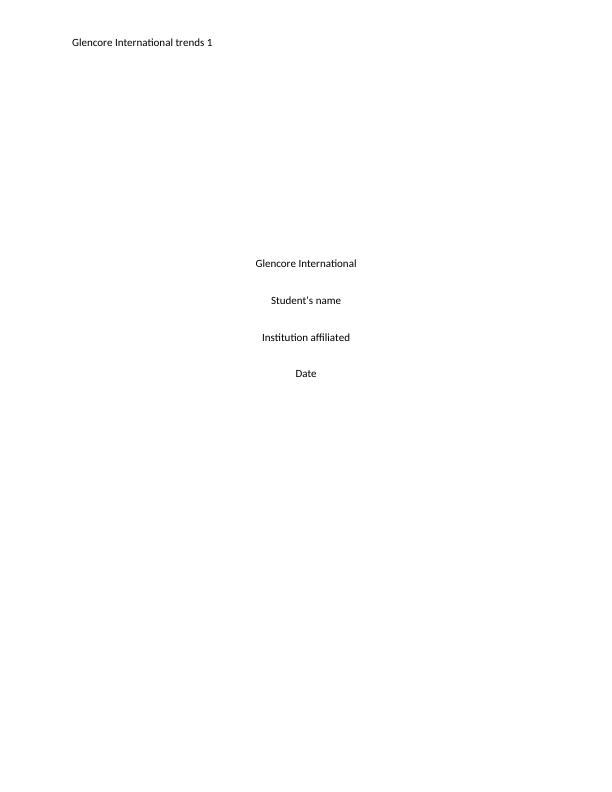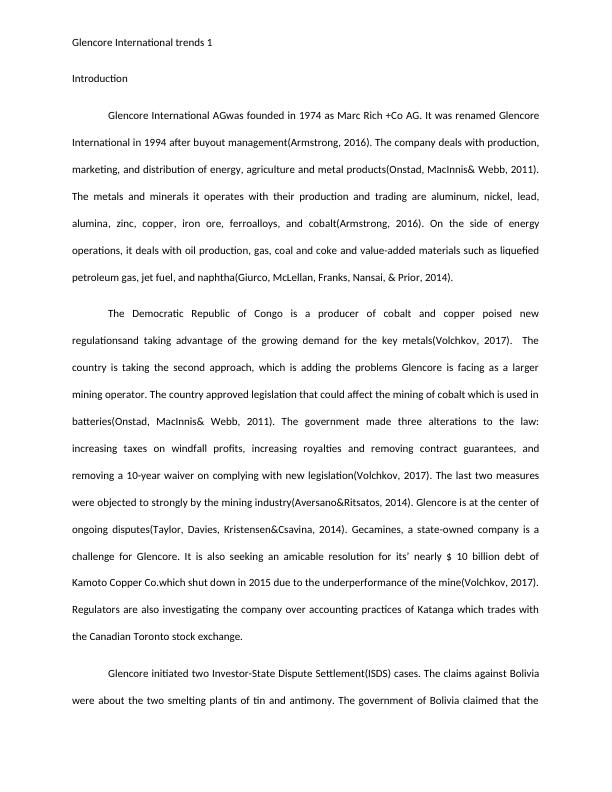Glencore International: Trends and Challenges in Mining and Trading of Commodities
Added on 2023-06-06
7 Pages1824 Words394 Views
Glencore International trends 1
Glencore International
Student’s name
Institution affiliated
Date
Glencore International
Student’s name
Institution affiliated
Date

Glencore International trends 1
Introduction
Glencore International AGwas founded in 1974 as Marc Rich +Co AG. It was renamed Glencore
International in 1994 after buyout management(Armstrong, 2016). The company deals with production,
marketing, and distribution of energy, agriculture and metal products(Onstad, MacInnis& Webb, 2011).
The metals and minerals it operates with their production and trading are aluminum, nickel, lead,
alumina, zinc, copper, iron ore, ferroalloys, and cobalt(Armstrong, 2016). On the side of energy
operations, it deals with oil production, gas, coal and coke and value-added materials such as liquefied
petroleum gas, jet fuel, and naphtha(Giurco, McLellan, Franks, Nansai, & Prior, 2014).
The Democratic Republic of Congo is a producer of cobalt and copper poised new
regulationsand taking advantage of the growing demand for the key metals(Volchkov, 2017). The
country is taking the second approach, which is adding the problems Glencore is facing as a larger
mining operator. The country approved legislation that could affect the mining of cobalt which is used in
batteries(Onstad, MacInnis& Webb, 2011). The government made three alterations to the law:
increasing taxes on windfall profits, increasing royalties and removing contract guarantees, and
removing a 10-year waiver on complying with new legislation(Volchkov, 2017). The last two measures
were objected to strongly by the mining industry(Aversano&Ritsatos, 2014). Glencore is at the center of
ongoing disputes(Taylor, Davies, Kristensen&Csavina, 2014). Gecamines, a state-owned company is a
challenge for Glencore. It is also seeking an amicable resolution for its’ nearly $ 10 billion debt of
Kamoto Copper Co.which shut down in 2015 due to the underperformance of the mine(Volchkov, 2017).
Regulators are also investigating the company over accounting practices of Katanga which trades with
the Canadian Toronto stock exchange.
Glencore initiated two Investor-State Dispute Settlement(ISDS) cases. The claims against Bolivia
were about the two smelting plants of tin and antimony. The government of Bolivia claimed that the
Introduction
Glencore International AGwas founded in 1974 as Marc Rich +Co AG. It was renamed Glencore
International in 1994 after buyout management(Armstrong, 2016). The company deals with production,
marketing, and distribution of energy, agriculture and metal products(Onstad, MacInnis& Webb, 2011).
The metals and minerals it operates with their production and trading are aluminum, nickel, lead,
alumina, zinc, copper, iron ore, ferroalloys, and cobalt(Armstrong, 2016). On the side of energy
operations, it deals with oil production, gas, coal and coke and value-added materials such as liquefied
petroleum gas, jet fuel, and naphtha(Giurco, McLellan, Franks, Nansai, & Prior, 2014).
The Democratic Republic of Congo is a producer of cobalt and copper poised new
regulationsand taking advantage of the growing demand for the key metals(Volchkov, 2017). The
country is taking the second approach, which is adding the problems Glencore is facing as a larger
mining operator. The country approved legislation that could affect the mining of cobalt which is used in
batteries(Onstad, MacInnis& Webb, 2011). The government made three alterations to the law:
increasing taxes on windfall profits, increasing royalties and removing contract guarantees, and
removing a 10-year waiver on complying with new legislation(Volchkov, 2017). The last two measures
were objected to strongly by the mining industry(Aversano&Ritsatos, 2014). Glencore is at the center of
ongoing disputes(Taylor, Davies, Kristensen&Csavina, 2014). Gecamines, a state-owned company is a
challenge for Glencore. It is also seeking an amicable resolution for its’ nearly $ 10 billion debt of
Kamoto Copper Co.which shut down in 2015 due to the underperformance of the mine(Volchkov, 2017).
Regulators are also investigating the company over accounting practices of Katanga which trades with
the Canadian Toronto stock exchange.
Glencore initiated two Investor-State Dispute Settlement(ISDS) cases. The claims against Bolivia
were about the two smelting plants of tin and antimony. The government of Bolivia claimed that the

Glencore International trends 1
mining rights had been awarded under suspicious means and that it nationalized them in the public
interest. Bolivia has taken several measures to prevent international courts from making decisions that
can be enforced against the country by foreign investors(Taylor, Davies, Kristensen&Csavina, 2014). The
country withdrew from International Centre for Settlement of Investment Disputes (ICSID). In 2015 it
introduced new domestic arbitration framework to keep the proceedings inside the country and subject
to Bolivian law and its authorities, including arbitrations involving foreign investors(Volchkov, 2017).
However, this did not deter Glencore from starting its ISDS case in 2016.
Glencore also sued the government of Colombia after it sought to revoke parts of an amended
agreement signed in 2010 to expand Calenturitas coal mine rin by Glencore’s subsidiary
Prodeco(Barkemeyer, Stringer, Hollins&Josephi, 2015).
Position in the global economy; Glencore is the leading mining company regarding revenue
generation globally. Its revenue has not been purely generated by mining alone, but also by trading
commodities. In market value, the company is ranked fourth among the mining companies(Armstrong,
2016). The company generated 205 billion U.S. dollars revenue back in 2017. Its income is distributed as
follows; energy products lead with 62%,metals and minerals 39% and the rest accounts for agricultural
products. Two-thirds of Glencore’s revenue emanates from Asia and Europe(Forsgren, 2017).
In global standing, Glencore is placed number four of the leading companies in mining in market
capitalization(Forsgren, 2017). It is thefirst among cobalt producers, fourth in copper production and
tenth in platinum production. It is ranked fourteenth among the top revenue-generating companies
worldwide(Forsgren, 2017).
. The company has been facing problem pile up in the Democratic Republic of Congo. Former
Mutanda shareholder is seeking compensation for a 19% stake(Ralston, Hargrave& Dunn, 2017). The
company’s relationship with the country is deteriorating(Ralston, Hargrave& Dunn, 2017). This is after a
mining rights had been awarded under suspicious means and that it nationalized them in the public
interest. Bolivia has taken several measures to prevent international courts from making decisions that
can be enforced against the country by foreign investors(Taylor, Davies, Kristensen&Csavina, 2014). The
country withdrew from International Centre for Settlement of Investment Disputes (ICSID). In 2015 it
introduced new domestic arbitration framework to keep the proceedings inside the country and subject
to Bolivian law and its authorities, including arbitrations involving foreign investors(Volchkov, 2017).
However, this did not deter Glencore from starting its ISDS case in 2016.
Glencore also sued the government of Colombia after it sought to revoke parts of an amended
agreement signed in 2010 to expand Calenturitas coal mine rin by Glencore’s subsidiary
Prodeco(Barkemeyer, Stringer, Hollins&Josephi, 2015).
Position in the global economy; Glencore is the leading mining company regarding revenue
generation globally. Its revenue has not been purely generated by mining alone, but also by trading
commodities. In market value, the company is ranked fourth among the mining companies(Armstrong,
2016). The company generated 205 billion U.S. dollars revenue back in 2017. Its income is distributed as
follows; energy products lead with 62%,metals and minerals 39% and the rest accounts for agricultural
products. Two-thirds of Glencore’s revenue emanates from Asia and Europe(Forsgren, 2017).
In global standing, Glencore is placed number four of the leading companies in mining in market
capitalization(Forsgren, 2017). It is thefirst among cobalt producers, fourth in copper production and
tenth in platinum production. It is ranked fourteenth among the top revenue-generating companies
worldwide(Forsgren, 2017).
. The company has been facing problem pile up in the Democratic Republic of Congo. Former
Mutanda shareholder is seeking compensation for a 19% stake(Ralston, Hargrave& Dunn, 2017). The
company’s relationship with the country is deteriorating(Ralston, Hargrave& Dunn, 2017). This is after a

End of preview
Want to access all the pages? Upload your documents or become a member.
